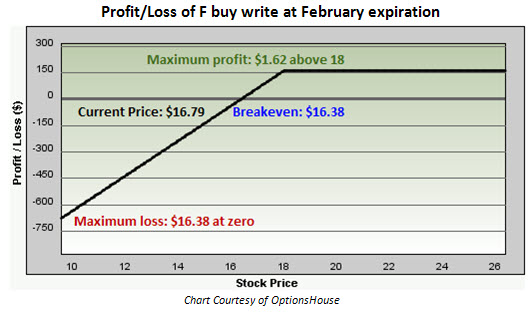 With General Motors GM available again for public trading, Ford Motor F has gone back to sharing the trading spotlight. But this doesn't take away from the stock's impressive performance; Ford shares are up 68% year to date and have climbed nearly 470% during the past two years.
With General Motors GM available again for public trading, Ford Motor F has gone back to sharing the trading spotlight. But this doesn't take away from the stock's impressive performance; Ford shares are up 68% year to date and have climbed nearly 470% during the past two years.
Last week, Mad Money host Jim Cramer reiterated his bullish take on Ford, noting that, “earnings power is huge and the balance sheet is getting better … it would not shock me to see Ford at $20 to $25 next year.” A move to $20 would be a 20% jump in the stock; a move to $25 would mean a gain of almost 50% from current levels.
Whether you agree with Cramer's view of Ford or oppose it vehemently, it may help you to consider option-trading alternatives to buying or selling the stock. In addition to leverage advantages, option strategies can potentially reduce capital outlay and help hedge your portfolio.
Stock traders who are new to the world of options trading can join me after New Years for our free Introduction to Options Trading webinar. The webinar will be held after the close on January 4; sign up here. I'll be accompanied by Carlos Portocarrero, an OptionsHouse employee who is new to options trading and may have some of the same questions you do.
As far as Ford is concerned, we have outlined two option strategies below – one covered call for the bulls and a long put spread for the bears. These descriptions are for educational purposes and do not constitute buy/hold/sell recommendations. All prices are as of Monday midday, when Ford shares were trading at $16.79, unchanged on the day.
Bullish Option Strategy: Covered Call
Ford bulls could consider a moderately bullish strategy such as the covered call, which allows for moderate upside but helps hedge against considerable downside in the stock. To trade a covered call, an investor could buy shares of Ford at $16.79 and sell the February 18 calls for 41 cents apiece. (When executed simultaneously, this strategy is referred to as a buy-write).
At expiration, the maximum profit for this strategy is $1.62, which is the difference between the strike price and the purchase price of the stock ($1.21) plus the 41-cent premium for the short call. Profit is capped at the 18 strike no matter how far the shares might rally. This represents just short of a 10% return on the cost of this strategy in just 60 days.
Below the breakeven price of $16.38 (the stock price less the credit collected), losses begin to increase because of the long stock holding. Losses are theoretically unlimited down to zero but the premium collected for shorting the call reduces the total risk by roughly 2.5%.
The chart below was built using a profit/loss calculator, which lets you change variables such as time until expiration and volatility movements. Open a virtual trading account to explore this and other tools such as the probability calculator and risk viewer.

Bearish Option Strategy: Bear Put Spread
Investors who think Ford may be due for a pullback could consider a bearish put spread, which consists of going long a higher-strike put and shorting a lower-strike put. The January 17.50/16 put is currently priced for a net debit of 72 cents. This premium is the maximum risk the spread buyer has if Ford is trading above the 17.50 strike when the options expire in 32 days.
Maximum profit is also limited at 78 cents, or the difference in strike prices less the premium paid. Profit peaks if Ford is trading below 16 when the options expire. This is a return on risk of 108%. Breakeven for this strategy is $16.78 at expiration – the long strike less the premium paid.
At the outset of the trade, the spread has a delta of -39, meaning it will theoretically gain 39 cents for every $1 decline in Ford and lose 39 cents for every $1 increase in the stock. Delta is dynamic, however, due to changes in volatility, time until expiration, and underlying stock price.

Photo Credit: Hugo90
The above information is provided by OptionsHouse, LLC (“OptionsHouse”) for informational and educational purposes only and is not intended as trading or investment advice or a recommendation that any particular security, transaction, or investment strategy is suitable for any specific person. You are solely responsible for your investment decisions. Commentary and opinions expressed are those of the author/speaker and not necessarily of OptionsHouse. Neither OptionsHouse nor any of its employees, officers, shareholders or affiliated companies guarantee the accuracy of or endorse the views or opinions of guest speakers or commentators. Projections or other information regarding the likelihood of various investment outcomes are hypothetical in nature and are not guarantees of future results. Any examples used that discuss trading profits or losses may not take into account trading commissions or fees.
Share and Enjoy:














Related posts:
© 2024 Benzinga.com. Benzinga does not provide investment advice. All rights reserved.
Comments
Trade confidently with insights and alerts from analyst ratings, free reports and breaking news that affects the stocks you care about.